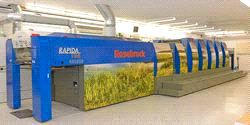Offset Printing
KBA Rapida 106 at northern German label printer

Tuesday 28. October 2014 - Druckerei Rosebrock: High-tech RAPIDA 106 with KBArt design
What could be more captivating than designer artwork? An own design! This is why a five-colour Rapida 106 decorated with an individual KBArt design has been in operation at Druckerei Rosebrock in Sottrum, near Bremen in Germany, since June.
The proprietors of this family-run printing firm wished to extend their environmental philosophy to the press room. Therefore a river can be seen flowing from the feeder, across the printing units and coater to the press’ delivery. The printshop’s logo is also displayed there ensuring that the company’s corporate design can even be seen in the press room. “It really is ours now”, says Lars Rosebrock proudly. Nevertheless, it wasn’t just the press’ innovative design that led to Rosebrock’s investment.
At the beginning of the 1990’s Druckerei Rosebrock specialised in the production of wet-adhesive labels. Some 40 per cent of jobs come from the label sector, however, in terms of tonnage it outweighs commercial and packaging printing considerably. The family-run firm employs 35 staff to support its customers in Germany and abroad. When printing labels the focus is not just on printing 100m, like other specialists. Instead Rosebrock predominantly handles small and medium-sized jobs which are less lucrative for big players. This segment is growing as the variety of products is continually increasing from labels for fruit juice, canned vegetables to pet food. Rosebrock produces 150 different types of labels in jobs consisting of 5,000 up to 100,000 pieces a week. Larger jobs can also be stored, if the customer wishes. However, storing one million labels for one product type is extremely rare. Due to increasing regionalisation and variety sometimes orders total only 500 labels per product.
Minimal lead times and fast job changes
Brothers Bernd, Lars and Sven Rosebrock also print commercial jobs at high speed. They share the management of the firm. One customer needs approx. 1,000 new A0 posters a week for its some 200 discount stores. As the advertisement is tailored to certain regions the posters are only slightly similar. Small jobs of occasionally only two pieces are produced digitally and jobs of 150 upwards are printed on the Rapida 106. Fast job changes and a high level of substrate flexibility were the key criteria when choosing the new press.
The two previously implemented B3 presses no longer printed economically. At times both had similar levels of utilisation, and then jobs for the press without coater dried up. Therefore the firm decided to bundle all print activities onto one high-performance press whose capacity would not yet be exhausted with these jobs. The Rapida 106 met these expectations. Its short makeready times ensure the economical production of extremely small jobs.
The new coater is a quantum leap forward: “We couldn’t imagine anything better,” says Sven Rosebrock, the managing director responsible for print activities. Blister coating is run at 16,000sph and more. The time needed for changing coatings and anilox rollers has been cut by a quarter compared to previous presses. Focus was also placed on the times necessary for washing rollers and changing ink as special colours are used permanently. Fast ink unit washing on the Rapida 106 has shortened this process by three minutes and the time required for a complete ink change has halved.
Reduced consumables consumption
The press operators’ daily work is facilitated by further features, such as inking units which can be decoupled. The fifth unit is decoupled in preparation for a four-colour job, saving roller oil and washing agent. This is in addition to the Rapida 106’s extremely low level of cleaning agent consumption. 20 litres last an entire week. Previous presses with brush washing systems needed two canisters per day. The total consumption now stands at 13 to 15 per cent of the previous amount. The blankets are even cleaner than before and are completely dry after the washing process. The amount of alcohol in the dampening solution has also been reduced. In addition, the film in the ink ducts which is prone to wear and tear is also no longer necessary. In the past the film had to be changed once a week which also took time. The Rapida 106 without film is considerably more stable when it comes to ink supply, a key benefit in label printing.
The printing house is fully equipped with a complete pre-press with UV plotters and digital printer, print technology, a label press line with two Busch die-cutters as well as a new Bograma rotary die-cutter for folding carton and blister cards. A shrink-wrap tunnel as well as the complete post-press kit for brochures round off the firm’s range.
Specialisation offers planning security
Specialising in small to medium-sized jobs in the label sector offers a more balanced capacity utilisation which delivers significant advantages. “We know now what labels we will be printing in January,” says Bernd Rosebrock. In commercial printing such long-term planning would be unthinkable, apart from printing periodicals. In contrast: if Rosebrock only printed labels on the new press in three shifts for two days, post-press wouldn’t be able to keep up. Depending on what the future brings for Druckerei Rosebrock it has 2,000m² of land as its disposal for possible expansions. Between 1973 and 2002 production space at the firm’s present site has grown six times to its current size of 1,500m².
